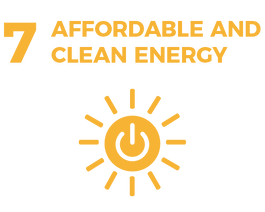Progress Report
SDG 7
January 2023
Reduce the number of people experiencing energy hardship in the Waikato from 18,000 in 2019 to zero by 2030.
ACHIEVING OUR TARGET
MEANS THAT:
All of our people, including those on fixed incomes (like the elderly and unemployed), can live in a warm energy efficient home, with reliable affordable clean energy.
*A working definition of energy hardship is those spending more than 10% of their income on energy in a month.
Global Picture
Despite progress, there are still over 700 million people globally living in the dark and 2.4 billion cooking with harmful and polluting fuels. Although the use of renewable energy and energy efficiency have improved, progress is not fast enough to achieve Sustainable Development Goal 7. The war in Ukraine is driving up global energy prices and increasing energy insecurity in Europe. To respond to the energy crisis, some European countries plan to speed up the transition to renewables and increase investments in renewables and energy efficiency, while some other countries plan to bring about a resurgence of coal, putting the green transition at risk.
The share of renewable sources in total final energy consumption amounted to 17.7 per cent globally in 2019, which is less than one percentage point higher than the figure for 2015. The electricity sector records the largest share of renewables in total final energy consumption (26.2 per cent in 2019) and drives most of the growth in renewable energy use, while the heat and transport sectors have seen limited progress.[1]
Aotearoa | New Zealand Picture
According to the Energy in Aotearoa | New Zealand report in 2021[2],
According to the Energy in Aotearoa | New Zealand report in 2021[2],
Two new wind farms were brought on-line with 223 MW in generation capacity
28.4% of energy consumption came from renewables
Wind turbines generated enough electricity to power around 360,000 homes
There were 28,212 EV's in Aotearoa | New Zealand at the end of 2021
68% of refined oil products came from Korea and Singapore
Aotearoa | New Zealand consumed enough petrol to fill 1,160 Olympic sized swimming pools in 2021
Coal imports reached a record high of 1.8m tonnes
National energy consumption increased in 2021 but did not return to levels seen before the beginning of the COVID-19 pandemic. The share of total energy supply from renewables was at its highest level since reporting started in 1990, at 40.8 per cent.
Natural gas production fell 13 per cent in 2021 because of lower output from the Pohokura field. The combination of low lake levels and the fall in natural gas production saw coal use for electricity generation increase by 29.5 per cent. Despite high coal use for electricity generation, the renewable share for electricity generation increased to 82.1 per cent for 2021, up from 81.1 per cent in 2020.
During 2021, Aotearoa | New Zealand became a net importer of energy. While crude oil is produced in Aotearoa | New Zealand, nearly all of this is exported as it is not suited to current refining capabilities and can achieve a higher price on international markets. Each year approximately half our national coal production is exported. Aotearoa | New Zealand imported 69 per cent more coal compared to 2020 and became a net importer of coal for the first time since reporting started. Imports of oil and oil products decreased by 4 per cent, which is the lowest amount since 2002. The national average of self-sufficiency was at its lowest level since reporting started in 1990, at 72.4 per cent in 20211. This was driven by decreases in the self-sufficiency of oil and coal.
National energy consumption increased by 0.7 per cent compared to 2020 but was still down 6.6 per cent compared to 2019. The greatest increase in 2021 was in the transport sector. Residential consumption in 2021 increased 1.5 per cent compared to 2020 and 3 per cent since 2019. Use of both electricity and natural gas increased 5 per cent compared to 2019. Energy consumption for transport peaked in the June quarter as Aotearoa | New Zealand started quarantine-free travel with Australia on 19 April 2021.
National energy intensity has improved by an average of 1.5 per cent per annum between 1990 and 2019. Energy intensity for all sectors decreased this year, with the biggest decrease in chemicals and metals which decreased by 11.2 per cent compared to 2020.
Some of this decrease can be attributed to Methanex reducing its natural gas usage and producing 19 per cent less methanol in 2021. National energy intensity decreased 4.7 per cent in 2021 compared to 2020.
Network electricity Price data from MBIE[3] shows that retail electricity prices across Aotearoa | New Zealand have increased on average by 7.7% from February 2019 to August 2022, or an average annual increase of 2.21%. In the same timeframe retail electricity prices in the Waikato increased 6.9% or an average annual increase of 1.97%.[4]
BERL reported on energy wellbeing indicators in Aotearoa | New Zealand in 2022[5] The reported noted the result of survey research undertaken by Habitat for Humanity and AMI Insurance which found that:
42 percent of respondents were worried about dampness
10 percent of respondents were concerned about significant mould
60 percent of respondents who were private renters were concerned that their home was
too cold
39 percent of respondents used electric plug-in heaters to keep their homes warm
26 percent of respondents used a wood burner or open fire
33 percent of respondents stated their winter power bill was excessive
43 percent of respondents reported having both underfloor and ceiling insulation, but the
majority had just one form of insulation.
The BERL report also noted an analysis, published by the Population Association of Aotearoa | New Zealand, which found:
47.2 percent of houses had roofs in excellent or good condition, and they were more likely to be in better condition for houses that were occupied by owners
Owner occupied houses were more likely to have better condition cladding than rented houses.
Rented houses were more likely to have defects with windows, with 58.1 percent of rentals indicating at least one defect compared to 42.1 percent of owner-occupied houses.
Blocked guttering was found in 17.5 percent of rented houses and 9.3 percent of owner-occupied houses
49.2 percent of houses had less than adequate levels of insulation in the roof space, and there was no difference between rented or owner-occupied houses on this measure
75.7 percent of houses were entirely single glazed. Double glazing significantly improves the thermal performance of a house. Owner-occupied houses were twice as likely to be double glazed than rented houses
72.5 percent of houses lack any kind of ground moisture barrier
Rented houses were more likely to have no heating measures, portable electric heaters, or fixed electric heaters (not heat pumps)
[1] Goal 7 | Department of Economic and Social Affairs (un.org)
[2] Energy in Aotearoa | New Zealand 2022 (mbie.govt.nz)
[3] Quarterly Survey of Domestic Electricity Prices (QSDEP) 15 August 2022 (mbie.govt.nz)
[4] The Waikato rates are taken as the average of individual prices from WEL Networks, PowerCo (Thames Valley), Waipa Networks, Unison (Rotorua), unison (Taupo) and The Lines Company (Otorohanga)
[5] Energy wellbeing indicators in Aotearoa | New Zealand (berl.co.nz)

